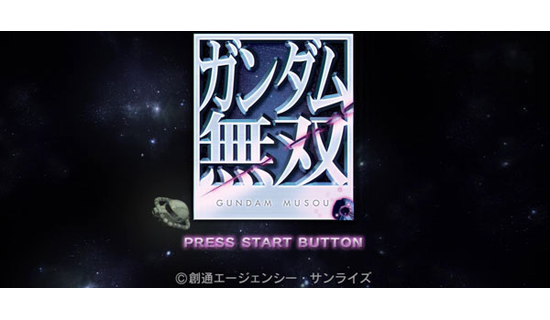There have been a ton of different Gundam games over the years, but the best regarded ones tended to be either fighting games or strategy RPGs. Gundam Musou was the first time that Koei Tecmo put a separate licensed property into a game in its already long running history of Musou titles, which until now had been completely focused around characters from Chinese or Japanese history. This decision didn’t make a lot of Gundam fans happy though: The less artful, repetitive nature of a beat-em-up in the Musou series probably just felt too far away from those Gundam games everyone loved. But does Gundam really fit so badly into the Musou template? Sure it doesn’t have the depth of a good fighting game or require the thought of a strategy RPG, but I’d argue that the fit turned out to be a rather good one.
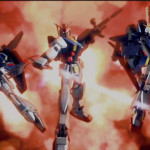 | 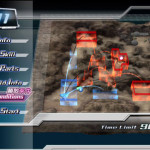 |
| As is usual for the Musou series, the pre-title screen cut scenes look fantastic! | The usual pre-mission screen, but Gundam style! |
I make this argument as both a fan of the Gundam franchise (particularly the early series that this game primarily features) and as someone who sometimes enjoys Musou games (though mostly those that are made from other licensed franchises). Since this marks the first time that a Musou game was created with licensed characters, one big Musou norm is made that much more interesting to those who are Gundam history literate: You always have a base history that everyone is familiar with, but it gets turned on its head by involvement from characters that weren’t actually involved in it at all. This is also one of the first few Musou games to appear on the XBox 360 (only beaten out by Shin Sangoku Musou 4 Special and Empires, and Sengoku Musou 2), and the very first one to appear on the Playstation 3. Some differences in core gameplay mechanics have been made to make Gundam Musou feel quite a bit different from the rest of the series. There’s now an SP gauge that differs from the Musou Ranbu special move that’s been used up until this point. The moves that the three levels of the Sp gauge allow you to use are not interrupt able by normal attacks, and it’s much easier to build up the gauge. The combo system has also changed up, given the ability to use charged attacks, the beam rifle and dash canceling. As a side effect of the changes to the combo system for Gundam Musou, the game actually feels considerably speedier despite the fact that you’re piloting giant robots. And of course the usual light strategic elements of the Musou series are here as well, offering a little something for the strategy RPG fan that enjoys the occasional beat-em-up.
Official Mode is basically the game’s story mode (the equivalent of Musou Mode), where you play through abbreviated versions of the stories of six main characters from Mobile Suit Gundam, Zeta Gundam, and ZZ Gundam. While it is fun to play through these well known story points, the game’s real meat is arguably in the Original Mode. Not only are there 16 characters to choose from (including a few from G Gundam and Gundam Wing), but characters now interact across Gundam series, pilots can use any mobile suit, and those familiar with each other from cannon plots often end up with completely different relationships. As a Gundam fan, there’s something strangely interesting about seeing Kamille Bidan and Haman Karn as allies. Both pilots and mobile suits can be leveled up, skills can be earned to modify specific traits of both pilot and mobile suit, and parts can be collected to modify health, attack and defense. Of no consequence to most players is the Versus mode, in which two players can face each other in a one-on-one battle. There’s also a gallery where you can look at images, hear spoken quotes from each character, and see various statistics.
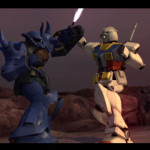 | 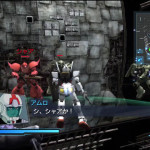 |
| Amuro vs. Ramba Ral: Zaku to chigau no da yo, Zaku to wa! | And of course we have to have Amuro vs. Char! |
To top it all off, any mission in any mode can be played in local 2-player co-op, in typical Musou fashion. And given the difficulty of many Original Mode missions (as well as some of the later Official Mode ones), having a co-op partner is highly recommended. On this subject, this game also follows a trend that the Musou series continues along with for some time: Being incredibly behind the times in terms of online connectivity. This game in no way acknowledges that it’s being played on a potentially Internet-connected system, offering neither online multi-player nor DLC of any kind. This had led some to believe that this title began development as a PS2 game (it would have a PS2 version later on), though I’d guess that this is just the way that Koei handles the Musou series: Why bother with big innovations when we know people will buy the games every time anyway?
In the west this title released simultaneously on both XBox 360 and Playstation 3, though in Japan the XBox 360 version would be released later in 2007 in a slightly modified form as Gundam Musou International. The western releases featured only English voice tracks for the characters, though this would eventually change. The Japanese International version of XBox 360 would feature the ability to toggle between English and Japanese voices for the characters, though I don’t know why you’d want English voices instead of the fantastic Japanese voice cast.
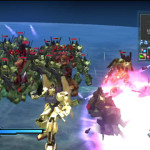 | 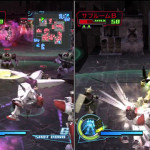 |
| Quattro kicking the crap out of Jared and Kacricon | Some co-op with The Dream Team: Char/Quattro and Haman Karn! |
I would strongly urge Gundam fans who have already decided this sort of game isn’t for them to actually give it a try: You may actually enjoy its simplistic and sometimes challenging gameplay. And as a Gundam fan, you’ll almost certainly enjoy the story elements if you can just let yourself go a little bit. And if you’re at all interested in Musou games but not necessarily a Gundam fan, this title is still worth trying because of the significant changes made to the old Musou formula. Just because Gundam Musou is a part of a long running series known for its lack of variety, doesn’t mean it suffers from exactly the same problems.
